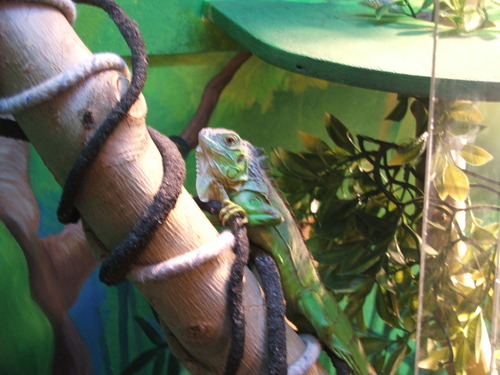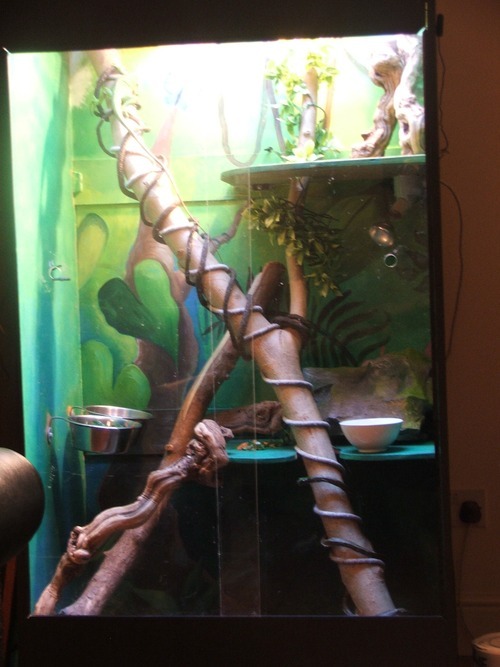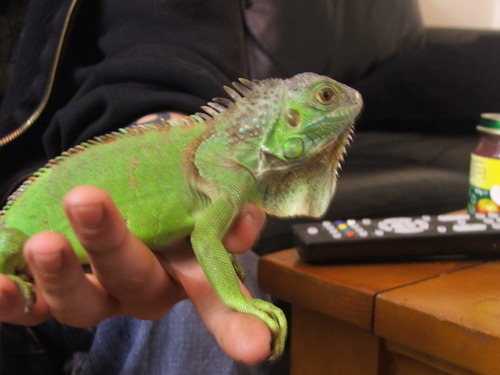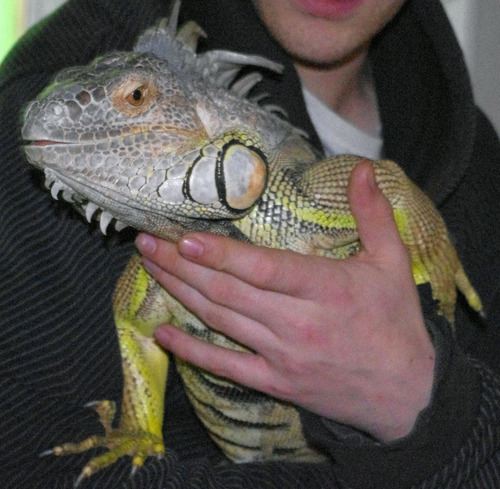Preparing the Iguana's first enclosure
As mentioned in our previous post, when we first acquired Jäger we had already prepared his enclosure before buying him and bringing him home. We were aware that we needed to properly disinfect the space using proper reptile disinfectant, of which there is a choice of many in any good pet store. We recommend you do this whenever transferring your reptile to a new set-up regardless of whether it is shop bought, second-hand or hand made.
Initial Lighting and Heating Set-Up
We then set about getting his lighting established and making sure his temperatures were adequate over the course of two weeks-before bringing him home. Upon regularly recording his temperatures on a daily basis for a fortnight, we could ensure that his prospective new home did not experience any drastic rises or drops in temperature before moving him in. We must always bear in mind that internal vivarium temperatures are always affected by external conditions, so if you live in a temperate climate like we do where the weather can't quite make up its mind, it is always good practice to ensure temperatures remain at a constant average
before transferring an iguana into a new home. This will allow for a less stressful transition and will allow you to ensure everything is good to go.
Products used
To be specific about the lighting,we used an Exo Terra 12.0% UV tube and an Exo Terra Basking light along with a 250watt Ceramic bulb to keep the ambient temperatures. This was running on a pulse thermostat.The pulse thermostat basically regulates the temperatures in the vivarium, where you can set the highest and lowest temperatures acceptable, and it will pulse on and off once the set maximum temperature has been achieved to maintain ambient temperature. For green Iguanas, optimum temperatures are advised to be around 32 to 35 degrees Celsius in their basking spots. These temperatures are important because iguanas, like all reptiles, need the heat to get their blood warmed and circulating so they can digest their food properly. Also, with regards to UV lighting, we have to remember that these lizards would
naturally live in an area of the world where the sunlight is very intense, and UV levels are high. Iguanas rely on the natural sunlight to obtain vitamin D3, which contributes to healthy bone development. Never be persuaded to provide heated rocks for your iguana to bask/lie on, as these can inflict serious burns and your Iguana will not be able to sense the damage being done until it is too late.
In order to keep everything nice and regular for Jäger, we had his lighting set up to a timer, which ensured he would get a precise and predictable amount of time under his lights on a daily basis. This is excellent for if you have a mixed up work schedule like we do, where shift patterns alternate on a regular basis, and gives your Ig a sense of time that he would have in his natural habitat. Always remember you are trying to replicate his natural habitat as closely as possible. We have had his lights come on every morning at 7am and switch off at 8pm at night.
Diet
In addition to proper lighting, the diet of a green iguana must compliment the lighting to ensure optimum growth and ongoing optimum health.A green Iguana requires these light conditions, along with the correct temperatures to help him digest the nutrients he obtains from his food.Of course, if you have gone to the lengths of getting this first bit right then you will do well to be conscientious enough to research their dietary requirements. There is no point in providing all the correct temperatures and lighting if you don't research the importance of a good diet. An excellent list of foods is provided by The Green Iguana Society's website, which stipulates the proportions and regularity in which each food item should be provided.
MBD Metabolic Bone Disease
If these basic needs are not met your iguana will inevitably develop a very nasty and prevalent condition known as Metabolic Bone Disease(please Google MBD in iguanas to see examples).
This isn't something that 'might' happen to your iguana, this WILL happen if his diet and lighting aren't constantly kept up to scratch. This happens over the course of years as the iguana becomes more and more deficient in calcium supplies usually obtained through proper nutrition, and draws this from his own skeleton instead. This brings us to the importance of the Calcium Phosphorus ratio which is a dietary must throughout your Iguana's life. Providing adequate dietary calcium is absolutely essential for preventing the symptoms of MBD such as that of osteoporosis and hyperparathyroidism. Both Calcium (Ca) and Phosphorus (P) must be present in a ratio of 2:1 in order for them to fulfill the biological roles in an Iguana's body.To name but a few, these roles include the support of the correct functioning of cells, allowing for energy to be used by the body, regulation of nerve and muscle function and the mineralisation and maintenance of the skeleton and teeth. Should the diet become deficient and unbalanced, the iguana's body will compensate for this shortfall by compromising his own skeleton, stripping it of calcium.
The exact calcium and phosphorus ratios of different greens and fruits does vary however, with some being more suitable than others, so it is always good to check with a good point of reference if you are ever unsure. We do suggest this Green Iguana Food List
Fussy Eating Habits
In the pet store we got Jäger from, they were feeding him an awful lot of parsley in addition to exo terra juvenile iguana pellets sprayed with watered down fruit juice. They complained he was picky, and this was the only way to ensure he was eating. We quickly wanted to nip this issue in the bud, seeing as this approach basically facilitated the Iguana's 'pickyness'. We started by sticking to the limited foods he was used to and added additional dark leafy greens such as watercress,rocket and dandelion leaf(always rinse thoroughly). We also introduced small amounts of butternut, sweet potato and parsnip from day one, and continued to spray his food with the watered down fruit juice, until eventually we could remove the pellets and also the fruit juice from his water sprayed onto the food.
We found he absolutely adored the butternut and sweet potato boiled and mashed, and this was an excellent means of providing him with his Nutrobal supplements, since we could mix it into the mash and hide the taste and smell a little better. We did this every other day. After a fortnight of slowly introducing all of his staple food items and replacing his old pet store diet, (and removing the parsley!) he was happy to munch on his new salad. We did however keep his pellets for times when he did go off his food, and would give him them on these occasions to ensure he was getting some nutrition, then would start with the slow introduction of other greens and fruits until he was back into eating properly again. Never give into Iguana's fussy eating, they will have your life otherwise! We found he would go off his food in his first breeding season phase, and also if our work schedules changed or we got anything new, be it clothing or a throw for the sofa. Iguana's are incredibly perceptive to change and we have to remember this can be stressful for them as they do enjoy routine.
Another way of encouraging him to eat on a daily basis was to place a small handful on his favourite shelf to give him a 'taste' of what was waiting for him in the bowl below. He would munch on this first by about midday, then run down to his bowl to finish off his salad. We realised he'd be more than happy to sit on his basking shelf all day in his new vivarium, as this is where he felt most safe- so this was a great way to also get him to start exploring his vivarium.
Jäger's adult Diet
Presently, Jäger has a very varied diet, but we always stick to our main staples which never leave his salad mix. These are the products we can always guarantee we will be able to get a hold of all year round and include Spring Greens, Watercress, Dandelion leaf, sugar snap peas, Green beans, butternut squash, parsnip, courgette(zucchini),mango and Okra. We will then provide variations of other items over the course of a week depending on what we can get a hold of, which include banana, blueberry, raspberries, cucumber (small amounts usually for water if he doesn't seem to be drinking). It is rare we see Jager drink water from his bowl, so we always spray his food with fresh water and provide a little watermelon or cucumber to add to water content. We have found he particularly likes the food given to him as peeled, so using a potato peeler we peel up slices of butternut, parsnip, carrot and zucchini etc so that they're the thickness of a nice juicy leaf- again bearing in mind, in the wild food in leaf form would be the easiest for him to pick up in his mouth. We never provide him with citrus fruits, dog food (as we've seen advised on some sites) or any other protein based foods. These animals aren't omnivorous and despite other sources suggesting it may be OK to feed the occasional cricket, dog chow or meal-worm, we are of the belief that if he can do fine without them all of the time, it isn't worth the 'occasional' risk to his health on the off chance that this may be acceptable according to observation of them in the wild.
In our next Post we will recap diet and discuss socialising Jäger as a Juvenile as well as enclosure placement. .
Until then, Happy Reptile Keeping
Steve and Dawn :)




